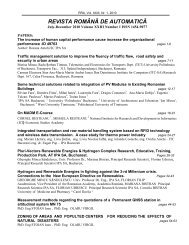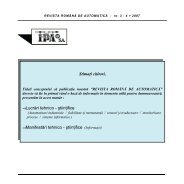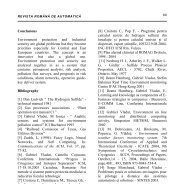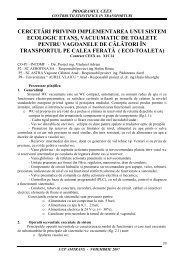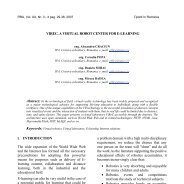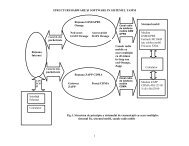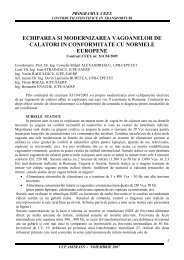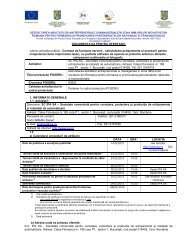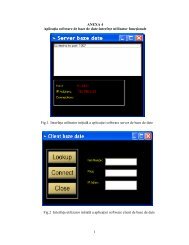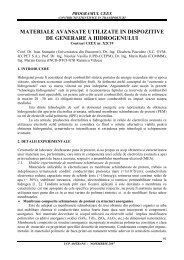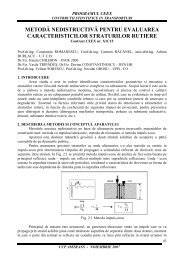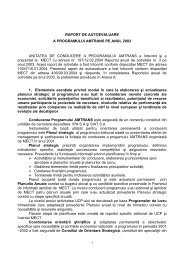REVISTA ROMÃNÄ DE AUTOMATICÄ - IPA SA
REVISTA ROMÃNÄ DE AUTOMATICÄ - IPA SA
REVISTA ROMÃNÄ DE AUTOMATICÄ - IPA SA
Create successful ePaper yourself
Turn your PDF publications into a flip-book with our unique Google optimized e-Paper software.
<strong>REVISTA</strong> ROMÂNĂ <strong>DE</strong> AUTOMATICĂ<br />
45<br />
Software components of the passenger<br />
information system:<br />
• software applications made in<br />
assembler and in VB.NET language:<br />
embedded application for local<br />
data acquisition and display;<br />
desktop application for central<br />
communications with the bus<br />
<br />
stations;<br />
desktop application for prediction<br />
of the bus station arrival.<br />
• Microsoft SQL Server 2005<br />
SMARTBUS central database.<br />
The prediction application for bus station<br />
arrivals<br />
The prediction application for the bus station<br />
arrivals of the VTP (Public Transport<br />
Vehicles) has the role to treat in real time the<br />
received position data from the buses and to<br />
provide estimated values for the bus station<br />
arrivals.<br />
The SMARTBUS software applications from<br />
the central level communicate with each other<br />
through common SMARTBUS SQLServer<br />
database tables.<br />
The updates interval for the bus station signs<br />
is 1 minute, and during this time the<br />
prediction application makes at least two<br />
estimations to calculate the prediction value.<br />
The application has been made to monitor the<br />
bus line 5 from Suceava city.<br />
The prediction algorithm is based on periodic<br />
readings of the bus coordinates and their<br />
comparison with the N points vectorized bus<br />
route. Thus the current positions are<br />
estimated and the delay values for each bus<br />
station are chosen relative to the current bus<br />
position (the calculated values are<br />
summarized to obtain the delay of the bus<br />
from the current position to the monitored<br />
station). The calculations are repeated for all<br />
buses on the route. The minimum value of<br />
these values for each bus station represents<br />
the estimated arrival time of the first bus.<br />
This value and the command buffer for the<br />
bus station sign are written in a database<br />
table, used by the local control application for<br />
the station signs.<br />
The delay values estimated and stored are<br />
obtained taking into account a value of 36<br />
km/h as a medium speed planned to cover<br />
the current line route. These values can be<br />
dinamicaly modified, applying a correction<br />
factor according to a particular case.<br />
In order to perform bus monitoring it was<br />
also implemented an algorithm which has as<br />
inputs the bus planned schedule taken from a<br />
database table and as output the analysis data<br />
regarding the realized bus schedule,<br />
depending on the information collected in<br />
real time. The status of the on-route vehicles<br />
can take 4 values: in time, in delay, in<br />
advance (headway), stopped because of<br />
technical problems.<br />
The informational panel<br />
The information panel is an alphanumeric<br />
display, AlphaEclipse type, used for public<br />
information. This is composed of a display<br />
panel made up by LED display modules, in a<br />
metal enclosure with the command and power<br />
elements.<br />
The displayed information is: the hour, date<br />
and temperature, the buses that are nearby the<br />
station; a summary description of the current<br />
routes (most significant points), text<br />
messages or graphic images.<br />
The main units that compose the electronic<br />
sign are: a) the controller board; b) the<br />
display module; c) the comon supply source;<br />
d) the thermostat.<br />
The text messages are sent from the software<br />
dispatcher described below.<br />
The software dispatcher for data<br />
communications with the bus stations<br />
The application for communication with the<br />
bus stations has the considerable role to<br />
render valuable the informations obtained<br />
from the equipments aboard the vehicles,<br />
transmitting the prediction data obtained at<br />
the central level to the local equipments in the<br />
bus stations, to display useful passenger<br />
information.



